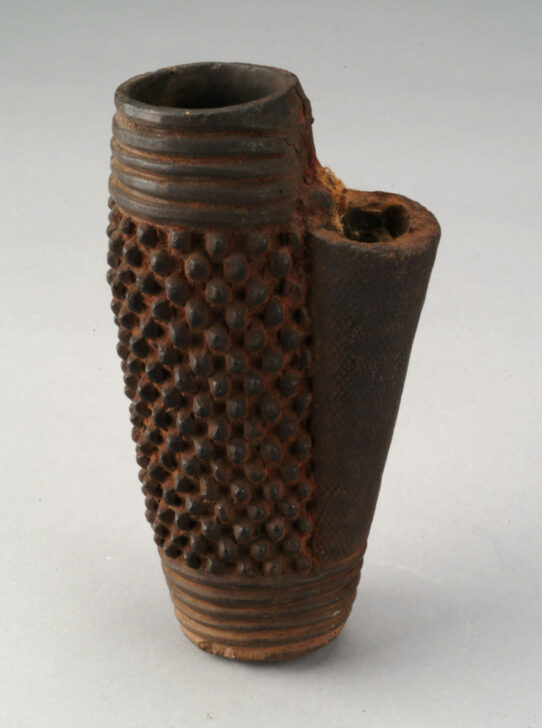Pipe Bowl
Bamum; Bamileke; North West Province

Description
Subject Matter:
Throughout the Grassfields region of Cameroon, material culture acted as a signifier of a person’s place within the social hierarchy that many kingdoms in this area share. The king, in some kingdoms called the fon, had control over what motifs or symbols could be used on different objects, such as pipes, by certain classes of people.
Both men and women often smoked, although the everyday use of plain tobacco pipes declined after World War II when cigarettes became increasingly popular. Prestige pipes with human and animal images, however, were, and still remain status symbols. Artisans from northwestern areas such as Bamessing, Babungo, and Babessi crafted highly decorated pipes from terracotta, wood, metal, as well as ivory. Brass obtained through trade was used to make pipes exclusively for the king or fon through the lost-wax casting method.
References Cited:
Gebauer, Paul. 1972. "Cameroon Tobacco Pipes." African Arts 5, no. 2: 28-35.
Gebauer, Paul. 1979. Art of Cameroon. Portland, Or.: Portland Art Association.
Homberger, L. 2008. Cameroon: Art and Kings. Zürich: Museum Rietberg.
Northern, Tamara. 1984. The Art of Cameroon. Washington, D.C.: Smithsonian Institution.
Page, Donna. 2007. A Cameroon World: Art and Artifacts from the Caroline and Marshall Mount Collection. New York: QCC Art Gallery Press.
Physical Description:
Terracotta pipe bowl in a cylindrical shape. The top and bottom edge are decorated with horizontal grooves, while the body of the bowl is covered with small round knobs. Another smaller, cylindrical projection—where the pipe stem would attach—is decorated in a crosshatch pattern.
Usage Rights:
If you are interested in using an image for a publication, please visit https://umma.umich.edu/request-image/ for more information and to fill out the online Image Rights and Reproductions Request Form.